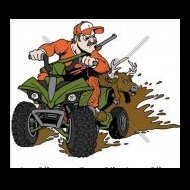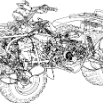Leaderboard
Popular Content
Showing content with the highest reputation on 01/01/2020 in all areas
-
"I hear ya and agree, the best part about this type of situation is all the members that go through this get very good at pulling the carburetor off so making several adjustments gets less difficult." He's got that right - "Frank" was not the name I'd given him when he recommended that I remove my king quad carb AGAIN to make adjustments - but it was worth it - he's a great teacher - and you do become somewhat of an expert at putting it back on (and taking it out, and putting it back on, and taking it out....). here are some tools I used to help: old long allen head wrench (used to put furniture together) - grinded off end to width of air/fuel screw under carb: it's long enough to access from the side "ol' red" - rounded/sanded an old slot head screwdriver: comes in handy when inserting TIGHT ARSE rubber boot between air box and carb - this gave me fits to no end - a bit of grease on inner lining helps, too old open end 12mm wrench for throttle cable - thinned it out w/ grinder: helps with final tightening of throttle cable to carb - this was difficult to get started but eventually seats2 points
-
Version 1.0.0
620 downloads
Also available on eManualOnline 1988-2002 Kawasaki Bayou 220 Service Manual PDF The Kawasaki Bayou 220 is one of the most common all-terrain vehicles on off-road trails that is geared toward novice riders and families. It’s also one of the smallest and most inexpensive ATVs on the market, with a retail price under $3,500, as of 2010. The Bayou 220 is Kawasaki’s only ATV of its size. The 220’s sibling is the larger Bayou 250 equipped with a 228cc engine. Engine The Bayou 220’s engine is a 215cc, four-stroke, shaft-driven, air-cooled model. Its bore measures 2.6 inches and the stroke is 2.4 inches. It features a relatively high 9.3:1 compression ratio with fuel delivered through a Mikuni VM24SS carburetor. The electronic ignition is Kawasaki’s DC-CDI. It also features a recoil backup as a starting system. The clutch is an automatic wet multidisc model with power delivered to the wheels via a five-speed transmission, according to ATV Source. Chassis The steel frame supports a front suspension with single A-arms and twin shock absorbers, with the rear suspension a Quad-Link system with two shocks. Front wheel travel is 4.5 inches, while the rear wheel travel measures at 4.9 inches. Front and rear brakes are drums. Size The front tire size is AT21X8-9 with the rear tires measuring AT22X10-10. The ATV’s wheelbase is 43.9 inches, with an overall length of 68.7 inches. Ground clearance is 6.1 inches with the seat height measuring 28.7 inches. It weighs 403 lbs. and can tow up to 450 lbs. Its fuel tank can carry 2.6 gallons. Basics The Kawasaki Bayou 220 is not the fastest ATV on the market, but one reason the Bayou 220 has kept its price low is the lack of amenities. It features a brake light and dual headlamps with high/low beam. There is an auxiliary lighting terminal inside the front cover of the ATV and electrical accessory terminals under the seat. The instrument cluster atop the fuel tank features a fuel gauge, but not much else. There are no speedometer, odometer, hourmeter, tripmeter, high-beam indication or high-temperature light. It does have a reverse/neutral indicator light. The Bayou comes in two colors: hunter green and firecracker red. Features The front A-arm, twin shock and rear Quad-Link twin-shock suspension system is not a true fully independent system, but it allows for a comfortable ride over rough terrain without employing a complex and expensive, fully independent suspension system. The ATV features front and rear steel cargo racks. The ATV is rider-friendly with a limited adjustable throttle to help novices practice their riding skills without twisting the throttle too far and losing control of the vehicle.1 point -
1 point
-
1 point
-
Thank you! Glad to be here and will start browsing for forum. No doubt I'll have questions along the way!1 point
-
1 point
-
1 point
-
I rode a Honda 50cc kids trike when I was a kid. Heard a quad was better... We'll see how it goes....1 point
-
Horrible, simply HORRIBLE! Are you kidding? They look brand new, man! Is it paint? Wax? Since I have no experience painting atv plastics, my only question would be how durable is it - if painted, how is the paint able to stick to the plastic AND REMAIN THERE? sanding / roughing and possibly priming the areas prior to painting likely helps with this. your experiment looks fantastic. and now i'm headed to the plastics posts. just read your post - makes sense - and it'll likely work. good test run for all.1 point
-
I hear ya and agree, the best part about this type of situation is all the members that go through this get very good at pulling the carburetor off so making several adjustments gets less difficult.1 point
This leaderboard is set to New York/GMT-04:00





















